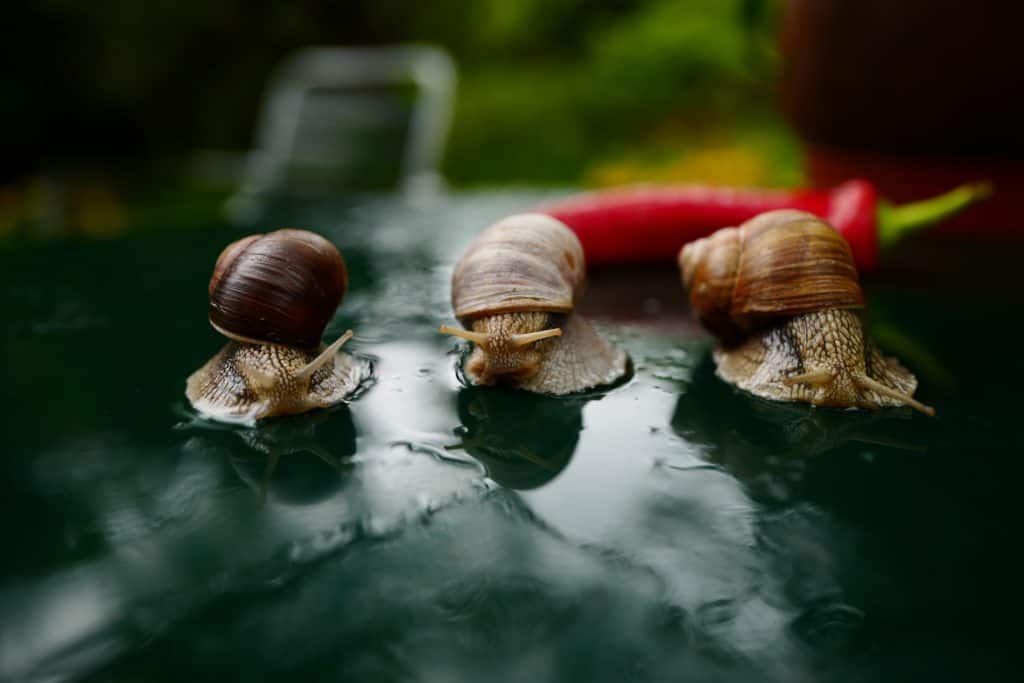Many people wonder how snails reproduce. Many know that snails are hermaphrodites but do not understand what this means.
Snails have a unique method of reproduction. In this article, you will find information linked to the method of reproduction of the snails, their characteristics, the seasons of reproduction, and the hatching of the eggs deposited by the snails.
If you have a pet snail, check out Can you bond with snails? to know more about snail emotions and brain.
to know more about snail emotions and brain.
Snails as hermaphrodites animals.
Snails have a very particular reproduction mechanism that is different from most other animals. They are hermaphrodites, which means they have both female and male organs at the same time. So they produce eggs and sperm at the same time.
This does not mean that all snails can be self-fertilizing. In fact, very few species possess this ability. Most snails need a partner in order to fertilize their eggs. Sometimes both will be fertilized, and sometimes only one individual will be fertilized.
This feature makes reproduction easier since any snail of the same species can reproduce with any other. They won’t have to worry about the sex of their partner.
Being a hermaphrodite increases the probability and effectiveness of reproduction. In addition, as they are hermaphrodites, each snail will be fertilized and will carry eggs with it after the mating act, which means that in a single encounter two individuals will lay eggs.
This doubles the efficiency of snail reproduction with respect to the reproduction of other beings.
Snails live an average of three to seven years and are able to reproduce from the first year of life. The fact that they can reproduce from the first year allows the species to be very prolific, which is very interesting for your snail production.
Their reproductive organs are located on the side of your body. This physiognomy facilitates the sexual act between two individuals.
Snails mating season
Snails will prefer to copulate when temperatures are still warm and the atmosphere is humid. They generally reproduce between spring and autumn to take advantage of the rains that improve the hatching of the young.
The summer will be too dry and the winter is too cold, so the snails will usually be in hibernation during those two seasons.
If you opt for the Combined breeding system technique, you will be able to create the necessary conditions for your snails to reproduce for two periods a year.
This way there will be more snails in less time. Thanks to indoor temperature control techniques, you will be able to create the perfect conditions in winter, so the snails will reproduce a second time.
How snails choose their partners and act of reproduction
To find a partner the snails will be guided by their sense of smell and touch since their sense of sight is very reduced and they have no sense of hearing. Snails are able to detect chemicals that give them information about the presence of another snail nearby.
Before moving on to the sexual act the snails go through a mating ritual. This ritual consists of a series of movements that the snails make as they gradually approach.
This ritual will be decisive in accepting the sexual act or not and can last between two and twelve hours, depending on the species of snails and the conditions that surround them.
At the end of the ritual, each snail usually fertilizes its partner and each one leaves with up to one hundred fertilized eggs.
- Snails will prefer to breed on warm, humid summer nights.
- After the courtship phase, the snails exchange a structure containing sperm through the reproductive organs that are located on the sides and that “connect” during the mating process.
- The sperm are released and reach the female reproductive system of one or both partners to fertilize the eggs.
Some species of snails are not hermaphrodites and each individual has either male or female reproductive organs. The method of reproduction is very similar. The difference is that in this case only the female individual will be fertilized and will lay eggs.

Love Darts!
After the courtship stage but before the sexual act, the snails throw a spicule of calcium carbonate or “love dart” at each other. Only snails that are sexually mature and have already mated at least once will be able to throw darts.
They are given this name because when they are observed closely, you can see a pointed shape at the end.
These darts are fired when the snails are in direct contact. Most of the time both snails throw this dart. It passes through the skin of the snail and into the body of the partner. This way the two snails are united.
This technique can be a little dangerous because sometimes the dart can go through some internal organs and hurt the snail.
During the first observations, it was believed that this dart was responsible for introducing the sperm into the body of its partner. However, this process is not directly related to snail ejaculation.
It has been proven that this dart and the substances it contains in its interior serve as stimulation during the act. Snails using this technique increase the chances of reproductive success.
Case of asexual reproduction
When we talk about asexual  reproduction, we often explain it as an emergency mechanism devised by nature in order for a species to prevail.
reproduction, we often explain it as an emergency mechanism devised by nature in order for a species to prevail.
Snails with this form of the reproduction will be able to fertilize their own reproductive organs. This means that they will not need a partner to carry out the reproduction.
Besides simplifying the process, this type of reproduction offers other advantages. Snails grow faster and reach reproductive maturity earlier.
Some experts suggest that asexual reproduction by consuming less energy, snails may use this energy to continue to grow or do so more quickly.
A known species that has this type of reproduction is the New Zealand mud snail (potamopyrgus antipodarum). This snail can reproduce sexually or asexually.
Laying eggs
When the sexual act takes place, each snail has up to one hundred fertilized eggs inside. The embryo begins to form when the eggs are still inside the fertilized individual. The snail will look for a fresh place to bury its eggs and let them grow.
Two to four weeks later the snails finish developing inside the egg. When they break the shell, their fragile shell will force them to quickly go into survival mode.
One of the first things they’ll do is find a source of calcium to harden and grow their shell. Snails find sources of calcium by gnawing on certain minerals or even eating their own or their siblings’ shells.
A snail is fully formed three months after its birth. During this time the snail will be kept in the nest where the eggs were laid.
Once it has acquired all the necessary nutrients and its shell has been strengthened, the snail will change location.
Managing this process as a snail farmer
For this method, you will use closed spaces where temperatures will be controlled and adapted. Humidity levels will also be crucial for the snail cycle.
On the first time, you will force hibernal conditions by the end of the summer. Then, you will create optimal reproduction conditions during the winter, so that little snails will appear in early spring, which will give them more time to grow, this time, in an open pen.
This means that you will be able to promote an entire annual cycle twice a year.
This method is used all around the world. Installations and maintenance are more expensive than traditional methods during the first year. However, it remains highly cost-effective over time.
If you use the traditional method of breeding, you should take into account all the factors mentioned above and adapt your breeding and maintenance routines to the breeding process.
All of this information to avoid failure like what happened in some Asian countries, as explained in Why Did Snail Farming Fail In Asia? .
.
Conclusion
As you can see, snails own a wonderful reproduction method, which reflects nature’s issues to ensure the survival of snails.
Some scientific techniques and observation tools have allowed us to better understand how these small animals reproduce.
The reproduction of snails is a topic that shows us even more how wonderful animals snails are!
